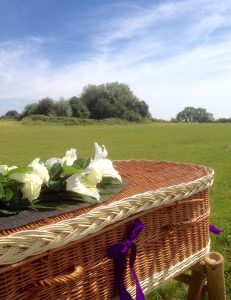
Whether a graveside ceremony follows a funeral ceremony or is a stand-alone event, this should be attended with the same attitude of respect and courtesy as a funeral ceremony or memorial ceremony.
What To Expect At A Graveside Ceremony
A graveside ceremony can follow a traditional funeral, can precede a memorial ceremony, or can be a stand-alone event. The ceremony will be held at the graveside, or at the place where the body or cremated remains will be interred. In general, graveside ceremonies tend to be fairly brief. The funeral celebrant will likely recite prayers or readings, a eulogy may be delivered, and the body will be lowered into the ground or casket / urn placed in the ground. In many cultures it is customary to have guests participate in shovelling/ scattering soil / sand / peat / seeds into the grave.
Where To Sit Or Stand At A Graveside Ceremony
Chairs may be set up at the graveside, though depending on the number of people in attendance most guests may need to stand. Generally, chairs are reserved for immediate family members and people who are elderly. If there are seats available, the congregants should feel free to sit.
Participating In A Graveside Ceremony
At a graveside ceremony the funeral celebrant or a funeral director—will usually recite prayers or readings before the coffin / casket / urn is lowered into the ground. If the prayers or readings are intended to be sung or read by the group, or if there are prayers that follow a call-and-response pattern, congregants should participate if they feel comfortable doing so. If they don’t know the prayers or readings, or do not wish to participate for any reasons, standing quietly and respectfully is acceptable.
Depending on the religious or cultural affiliations of the funeral, at some graveside ceremonies it is customary to have guests shovel / scatter soil / sand / peat / seeds into the grave. This is especially true of Jewish funerals. Though there is no obligation to participate in this activity, congregants should feel free to participate if they wish. There will usually be a pile / container of soil at al next to the grave and maybe one or two spades. Generally the immediate family will go first, and other guests will line up behind the family. If you get to the funeral and find that this is not the case, it’s always a good idea to simply follow the lead of the person in front of you.
If You’re A Pallbearer
If you are going to be a pallbearer at a funeral before the graveside ceremony or at a stand-alone graveside ceremony your job will be to escort the coffin from the hearse to the graveside. The funeral director coordinating the ceremony or someone from the burial facility will be on site to tell you where to go and what to do. If you have any questions about your role, simply ask the funeral director or burial facility staff member.
How To Know If You Should Attend A Graveside Ceremony
Graveside ceremonies may be open to the public or may be limited to family only. If a public graveside ceremony follows a funeral, the funeral celebrant will make an announcement at the end of the funeral inviting people to the graveside ceremony and offering directions to the burial facility. As with a funeral, if a graveside ceremony is open to the public and you want to attend, you should. If the ceremony is limited to family only, your should respect the family’s wishes and not attend. If you are not invited to the ceremony but would like to reach out to the family, consider writing a letter or card expressing your condolences.


